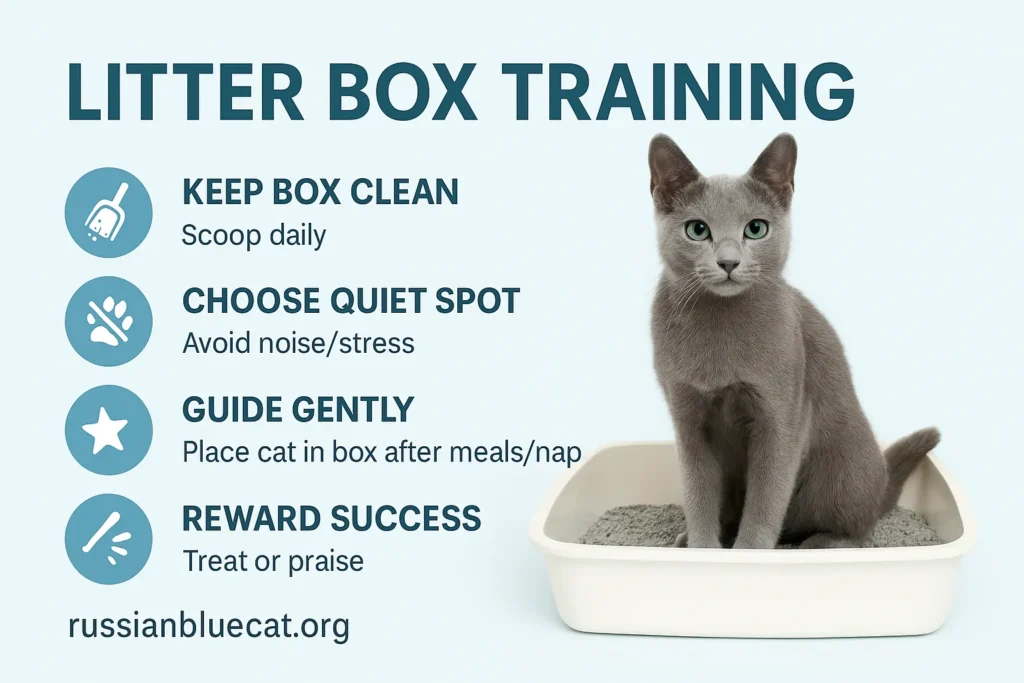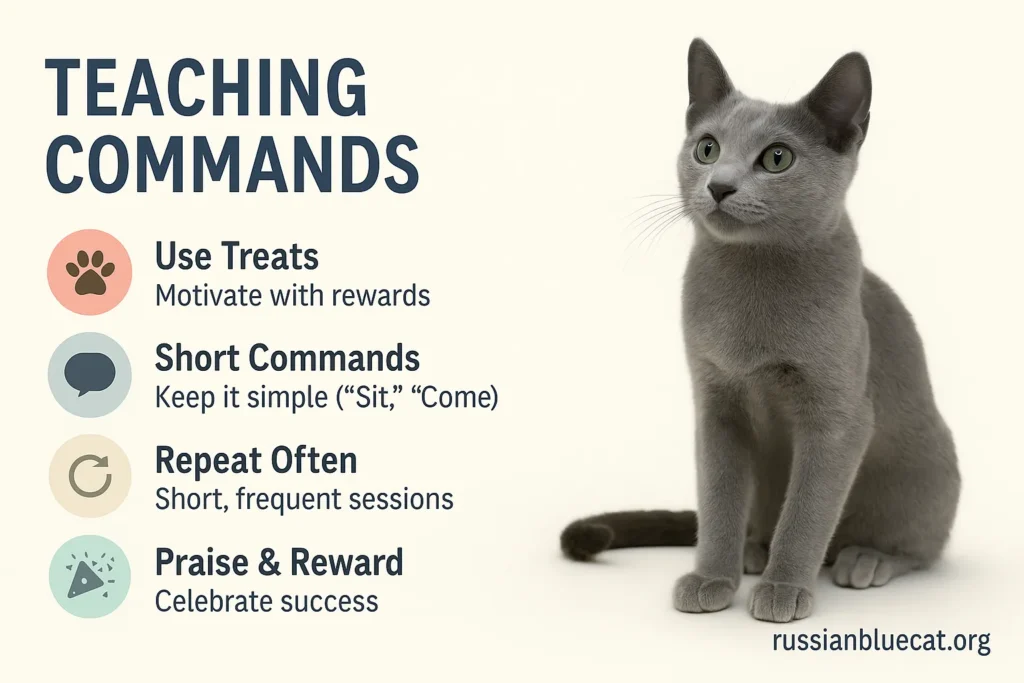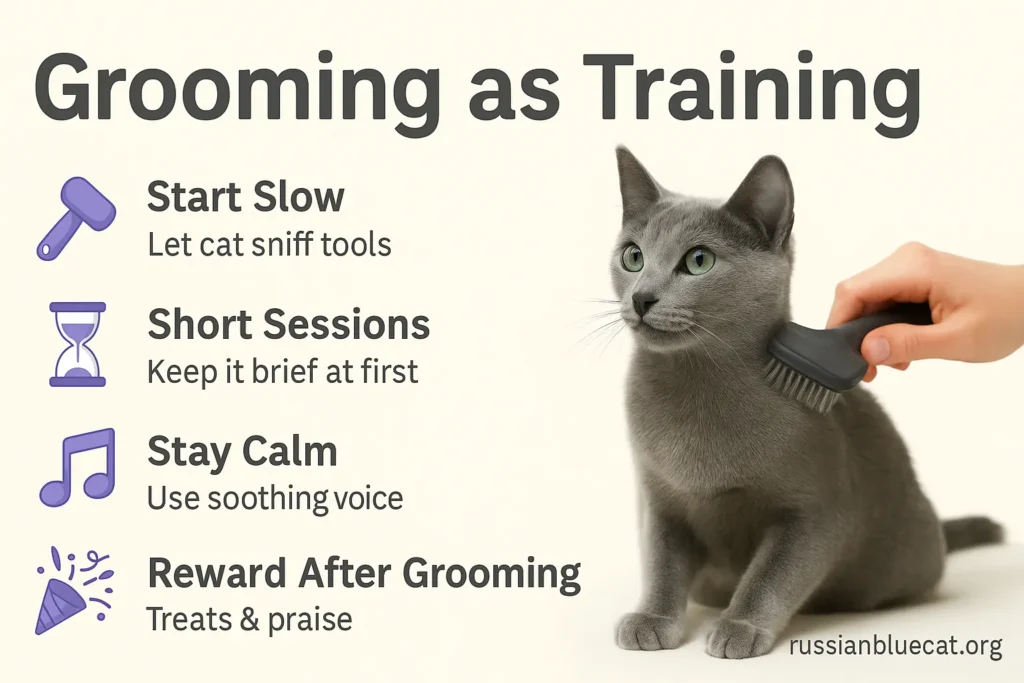From Stubborn to Smart: How to Train a Russian Blue Cat with Love in 2025

Introduction: A Breed That Thinks Before It Acts
If you are attempting to determine how to train a Russian Blue Cat, chances are you already have one of the smartest and most elegant breeds in the world of cats. The Russian Blues are loved for their brilliant silver-blue fur and emerald-like eyes, but it is their quick wit, sensitivity, and loyalty that make them truly stand out. Russian Blues are the kind of cats that watch carefully, analyze situations, and then decide how they want to respond. That makes them quick learners, but also means they require an owner who understands patience, consistency, and respect.
Training a Russian Blue is not about dominance; it is about communication and building trust. In this comprehensive 2025 guide, we will examine every detail of training from basic litter box use to walking on a leash, from controlling scratching behaviors to mastering sophisticated tricks. You won’t just learn to train a Russian Blue Cat by the time you finish this guide, but also how to turn training into a bonding experience that deepens your connection with this incredible breed.
Understanding the Russian Blue Personality
Russian Blues are often described as aristocratic cats. Their dignified posture and graceful movements give them an air of elegance, but their personality is a fascinating blend of intelligence and caution. They are observant cats who notice changes in their environment instantly. For instance, most owners talk of how their Russian Blue will know when the food cupboard is open or the vacuum is ready to be turned on and will bolt to safety before the sound is even made.
This breed feeds on routine and predictability. A Russian Blue enjoys knowing when mealtime is coming, where her favorite toy is stored, and which chair her owner typically sits in. Training sessions become much more effective if they are performed at the same times each day, strengthening their sense of structure.
Another significant trait is their sensitivity. Russian Blues do not like raised voices or punishment. They instead become withdrawn and possibly hide, refusing to work. They are best trained through positive reinforcement, where rewards and love shape desired behavior. That pairing of intelligence, devotion, and sensitivity makes them extremely trainable but only with the right trainer.
Preparing for Training
Before you start with formal training, you need to set up the environment and the equipment you will be using. Begin with rewards, as Russian Blues are very food-motivated. Use small, soft treats such as freeze-dried chicken bits or tuna flakes since they are easy to consume and do not take away from the session. A clicker is another useful piece of equipment, enabling you to mark good behavior with precision before rewarding.
The training space should be peaceful, quiet, and distraction-free. Select a room that is secluded from home noises such as television sets or crowded kitchens. Training sessions should be brief five to ten minutes at most since cats have short attention spans. Closing the sessions with a reward will make your Russian Blue identify training with pleasant experiences.
It’s also a good idea to prepare yourself mentally as the trainer. Russian Blues are slow learners. Some will learn a behavior within a week, and others will take a month. Patience, repetition, and rewarding small achievements rather than demanding immediate results is the key.
Building Trust Before Training
Trust is the keystone of any successful training experience. Russian Blues are naturally reserved and could take weeks to come fully around to a new owner. In this time, do not force interactions. Instead, let the cat come to you, and reward the cat for coming willingly with gentle praise or treats.
One of the best methods for establishing trust is interactive play. Feather wands or laser pointers get their hunting mechanisms going, producing a pleasant and rewarding relationship between you and your cat. As you persist in such play over time, the feelings of security and intimacy ensue. When your Russian Blue sees you as a friend instead of a menace, they will be much more receptive to formal training sessions.
Litter Box Training

Most Russian Blue cats instinctively use a litter box, but young kittens or newly adopted cats may require guidance. Place the litter box in a quiet, easily accessible location. If your home is large, consider having more than one box, especially during the early stages of training. After meals or naps, gently place your cat in the box to encourage use.
Hygiene is essential for this breed. Russian Blues are finicky about cleanliness and will not use a dirty litter box. Scooping every day and changing litter weekly makes the box appealing. Cleaning thoroughly with an enzyme-based cleaner if accidents do happen outside of the box will help remove odor. Punishment will only make the cat afraid, whereas calm redirection and positive reinforcement will easily train them to good habits.
Scratching Post Training
Scratching is normal behavior for any cat, and Russian Blues are the same. They scratch to stretch muscles, remove old nail sheaths, and mark territory. It’s not about eliminating scratching but about redirecting it from furniture to appropriate posts.
Position scratching posts in locations where your cat already scratches, like around the couch or bed. If the posts are hidden away in a corner, the cat might ignore them. To encourage them, sprinkle catnip or spray catnip oil on the posts. When you catch your Russian Blue scratching furniture, do not punish them. Instead, gently lift them up and set them beside the scratching post. The first time they use it, reward them with treats and praise.
With time, your cat will learn to love the scratching post and respect your furniture as being nothing of worth. Consistency and patience will convert the post to be their preferred outlet for this natural behavior.
Teaching Commands

Cats tend to be underestimated when learning commands, but Russian Blues break the rule. Their high intelligence makes them capable of learning simple commands such as “Sit,” “Come,” and “Stay.” Begin with “Sit.” Place a treat above your cat’s head so they instinctively lower their body. When they sit, say the word out loud and reward immediately. Practice daily until the action becomes automatic.
After your cat has learned “Sit,” it is time to teach them “Come.” Say their name brightly and reward well when they come to you. The key to this command is consistency be sure to use the same word and tone every time. With patience, your Russian Blue will learn to come promptly.
The secret to command training is brief, enjoyable sessions that leave a positive impression. Cats learn most readily when they are engaged not coerced, and Russian Blues, with their intelligent nature, appreciate the mental stimulation that command training offers.
Harness and Leash Training

One of the unique joys of training a Russian Blue is leash walking. With patience, these cats can safely explore the outdoors. Begin by introducing the harness indoors, letting your cat wear it for a few minutes each day. Reward calm behavior with treats. Gradually increase the time they wear it until they are comfortable.
Then, add the leash and walk indoors. Allow your Russian Blue to go at their own speed, rewarding them for peaceful steps. When they are comfortable indoors, transition to an outside area such as a yard or quiet garden. Never hurry this along; pushing outdoor walking too quickly can engender fear. With patience, leash walking is a delightful experience for cat and owner alike.
Socialization Training
Because Russian Blues are timid, socialization needs extra attention. Gradually introduce new individuals and let your cat approach them at their own convenience. Ask visitors to sit calmly and give treats instead of immediately petting the cat. With time, your Russian Blue will realize that strangers are not a threat.
Gradually expose your cat to typical household noises. Begin with low-level TV, followed by more intense appliances such as vacuum cleaners. Accompany every exposure with soothing reassurance and treats. Such gradual desensitization makes your Russian Blue increasingly adjustable and self-assured.
Advanced Training
After the fundamentals are learned, Russian Blues blossom in more sophisticated challenges. Clicker training works wonderfully. Begin by associating the sound of the click with a treat, so your cat learns to connect the noise with the reward. Next, employ the clicker to mark sitting, jumping, or high-fiving behavior. Eventually, you can learn sophisticated tricks and even brief routines.
Puzzle toys and challenge games are another great method of pushing their intelligence. Place treats in puzzle toys or underneath cups and challenge your cat to figure them out in order to gain a reward. Some Russian Blues also enjoy doing agility training, running through tunnels, ramps, and hoops. Not only do these stimulate their minds but also bring the cat and owner closer together.
Grooming as Training

Russian Blues need to be groomed to help keep their double coat plush, and it is a time when training can take place. Gradually introduce brushing, with treats and praise during the sessions. Brush two to three times a week to help remove shedding and matting.
Dental care is also a crucial habit. Begin by allowing your cat to taste cat-safe toothpaste, and then introduce brushing gradually. Ear and eye checks should be made regularly as well. Treating grooming as a training exercise creates positive connections that make it easier for your cat to be cared for throughout its life. You can check our detailed guide on Russian Blue Cat Grooming
Training Through Life Stages
Training requirements differ by age.
Kittens are impressionable and learn rapidly. Practice litter habits, scratching posts, and socialization early on.
Adults will have their habits, for better or worse. Consistency and patience are what it takes to reinforce good behaviors and redirect bad ones.
Seniors won’t be as energetic, but they can benefit from training. Address comfort-based routines such as grooming tolerance and gentle exercise that engage their minds.
Mistakes to Avoid
Training a Russian Blue involves being mindful of potential pitfalls. Punishment is the most debilitating error, as it destroys trust and develops fear. Long or repetitive sessions can also ultimately fail, causing boredom and frustration. Being inconsistent perplexes the cat, and overlooking small victories tapers progress.
The key to success is patience, repetition, and not overlooking any step forward no matter how small.
Health and Diet Connection
Training is simpler when your Russian Blue is in good health. A well-balanced diet with high protein helps maintain energy and concentration, while Omega-3 and Omega-6 fatty acids enhance brain function and coat condition. Proper hydration maintains energy levels, and regular vet visits help ensure that no health problem hinders training. Check our detailed guide on Russian Blue Cat Health.
FAQs About Training a Russian Blue Cat
Conclusion: Training with Love and Patience
The art of training a Russian Blue Cat has less to do with dominance and more to do with partnership. Russian Blues are thinking, feeling, highly attached cats that need the help of a patient, rewarding owner to learn almost anything from simple litter habits to complex tricks. But more than that, training establishes a bond of trust and affection that can continue throughout the life of the cat.
Your Russian Blue will not only be a stunning companion but a well-trained, devoted member of your family proof positive that it is not only possible to train a cat, but profoundly rewarding.






